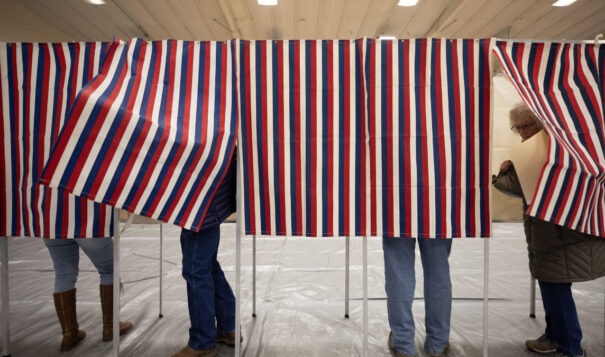News Based on facts, either observed and verified directly by the reporter, or reported and verified from knowledgeable sources.
Proposed ballot initiatives would mean big changes for Montana elections
 Voter Melba Anderson finishes up her ballot for the midterm election in Victor, on Tuesday, Nov. 8, 2022. Credit: John Stember / MTFP
Voter Melba Anderson finishes up her ballot for the midterm election in Victor, on Tuesday, Nov. 8, 2022. Credit: John Stember / MTFP
A pair of initiatives would create top-four primaries in the state and require winning general election candidates to receive a majority of the vote.
A coalition of former Republican officials and a longtime third-party candidate are pushing a pair of constitutional amendment ballot initiatives for the 2024 cycle that would fundamentally alter Montana’s elections in what they describe as an effort to “reform our broken political system.”
The most substantive proposal would create a system of top-four open primaries for most state and federal elections in Montana, regardless of party. That would replace the current system — in which a voter can participate in the partisan primary of their choice — with a primary akin to those the state holds for judicial elections.
Under the proposal, the four candidates with the most votes would advance to the general election, whether Democrat, Republican or otherwise, something the initiative backers say would create a more pluralistic government that doesn’t concentrate power in the hands of party leadership.
“We think Montanans have the right to demand responsiveness from their government and to insist on the benefits of competition when it comes to the people that represent them,” former Kalispell GOP lawmaker Frank Garner, one of the initiative backers, said in an interview Tuesday. “Here’s some breaking news: Not everybody feels served by their government. We need a system that serves the people and not the politicians.”
The second initiative would amend the Montana Constitution to require that winners of general elections receive a majority of the vote, as opposed to simply the most votes. The proposal assigns the Legislature the task of figuring out what happens if nobody gets more than 50% of the vote. That could mean holding a traditional runoff election or holding instant runoffs — a process more commonly known as ranked-choice voting, in which voters rank the candidates in order of preference until one candidate receives more than 50%. Such a process has become increasingly popular in states across the country, often to the chagrin of the party in power and of activists on the wings of both parties who rely on the deeply ideological primary electorate to bring their ideas to the fore. In Montana, Republicans during the 2023 legislative session passed a ban on the system that lawmakers would have to reverse in 2025 if they desire to implement ranked-choice voting under the ballot initiative, should it pass.
Collectively, Garner said, the changes would give more voters more freedom to elect candidates of their choice and ensure that the winning candidate actually has some version of majority support. Under the current system, he said, the small number of voters who actively participate in partisan primaries dictate the candidates available to the general electorate, creating a loop of increasing extremism.
“We’re always talking about how competition is a good thing, except when it comes to us,” Garner said.
If the top-four initiative is passed, Montana’s electoral system would resemble that of Alaska, where voters in 2020 approved a ballot measure creating top-four primaries, albeit by slim margins. That initiative, though, also instituted a ranked-choice general election, which is currently illegal in Montana.
The sponsors of the initiatives include several fixtures of the comparatively moderate wing of the GOP in Montana, including Garner and former lawmakers Rob Cook, Bruce Tutvedt and Bruce Grubbs. The other sponsors are Pondera County Republican activist and former state GOP central committee member Ted Kronebusch and former legislative and congressional candidate Doug Campbell, who has run for office in the past as a Libertarian, a Green and as an independent.
The top-four primary initiative would also add language to the Montana Constitution capping the signatures required to qualify for the primary ballot at 5% of the votes received by the winning candidate in the last election, something that would primarily benefit unaffiliated and third-party candidates who don’t automatically qualify for the ballot under state law. That threshold exists under current statute, but lawmakers have attempted to increase it in the past, including during the 2023 legislative session.
Campbell said that change would prevent the Republican and Democratic parties from manipulating the law in order to prevent third-party candidates from reaching the ballot. He said the two “minority parties” unfairly see third-party candidates as spoilers, and assume that Libertarians will sap Republican votes and Green Party candidates will take support from Democrats.
“If you have been an independent or third-party voter for a long time, you’re just not gonna vote for an R or D. The thought that ‘Well, if we don’t have that option, I’m going to pick someone else,’ is fallacious,” Campbell said. “When you have nothing but ugly candidates, you simply check out, you don’t participate.”
He said he realizes that a top-four primary may not advance third-party and unaffiliated candidates to the ballot in the general election, but it would at least ensure that voters have additional choices beyond the top Republican and Democratic candidates.
“Having a top-four, that gives us an opportunity to see somebody other than just the shoe-ins from the two parties,” he said.
The sponsors submitted the initiatives to Montana’s secretary of state last week. The proposals will need to pass a legal review by Attorney General Austin Knudsen, among other hurdles, before the sponsors can begin gathering signatures to qualify for the ballot in 2024.
